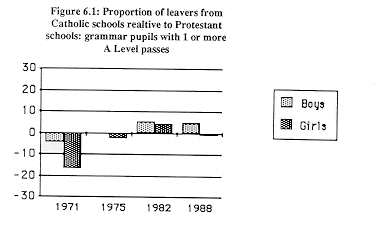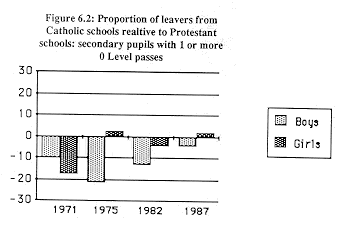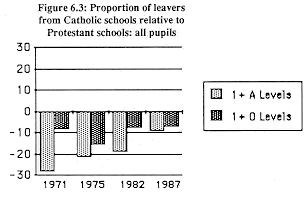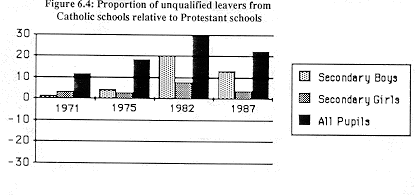
CAIN Web Service
Education and Religion in Northern Ireland
Section 6: Pupil Performance
[CAIN_Home]
[Key_Events]
Key_Issues]
[Conflict_Background]
Text: A. M. Gallagher ... Page Design: Fionnuala
McKenna
Material is added to this site on a regular basis - information on this page may change
Section Six
Pupil Performance
There exist a number of studies which have examined pupil performance
in Northern Ireland and allow for a comparison of performance
between pupils in Protestant and Catholic schools (eg Wilson,
1985; 1989; Sutherland and Gallagher, 1987; Gallagher, 1988; Osborne,
1986; Osborne and Cormack, 1989). However the most appropriate
sources are those cited in the previous section, that is Osborne
and Murray (1978) and Osborne (1985). 'These papers present school
leaver statistics for 1971, 1975 and 1982. broken down by sex
and the religious affiliation of the school, and permit the calculation
of a measure of relative performance between the religious school
systems. In addition, Osborne et al. (forthcoming) present school
leaver statistics for 1987. School leaver statistics are an appropriate
measure of performance because they indicate the educational output
of the schools into the labour market, and the further or higher
education systems. It should be noted that school leaver statistics
do not deal with a single age cohort as pupils leave post-primary
education between the ages of 16 and 18 years.
Relative performance
The school leaver statistics presented in these sources give the
percentage of pupils achieving defined levels of performance,
broken down by school type (grammar or secondary), sex and the
religious affiliation of the school. Using these data it is possible
to construct a measure of the performance of school leavers from
Catholic schools relative to that of school leavers from Protestant
schools. By this method, a relative performance score of zero
would imply that a similar proportion of leavers from Catholic
schools, as compared with leavers from Protestant schools, had
this level of qualification. A relative performance score of
less than zero would imply that a smaller proportion of leavers
from Catholic schools had this level of performance, while a relative
performance score of greater than zero would imply that a larger
proportion of leavers from Catholic schools has this level of
performance.
The next question concerns the level of qualification that should
be used for measuring relative performance. Since the performance
of pupils in grammar schools is very much higher than that of
pupils in secondary schools it was decided to use different levels
of qualification for both groups. For grammar pupils the calculation
was based on the percentage of pupils who left school with one
or more A Level passes: in 1982 this level of qualification was
achieved by over 60% of the pupils. For secondary pupils the
level was set at the achievement of one or more 0 Levels, or equivalent,
a level which was achieved by over 30% of the pupils in 1982.
Grammar pupils with one or more A Level passes
Figure 6.1 presents the relative performance of boys and girls
leaving Catholic grammar schools compared with boys and girls
leaving Protestant grammar schools for 1971, 1975, 1982, and 1987.
At this level of performance the graph indicates that the relative
performance of boys leaving Catholic schools wAS slightly lower
in 1971, about equal in 1975 and slightly higher in 1982 and 1987,
as compared with boys leaving Protestant schools. By contrast,
the relative performance of girls leaving Catholic schools was
very much lower in 1971, slightly lower in 1975 and slightly higher
in 1982; in 1987 the proportion of girls leaving Catholic grammar
schools with one or more A Level passes was equal to that of girls
leaving Protestant grammar schools.

Overall, figure 6.1 suggests that among grammar school leavers
the proportion of leavers from Catholic schools with one or more
A Level passes had been lower than that of leavers from Protestant
schools in 1971, but by 1987 a position of relative parity had
been achieved.
Secondary pupils with one or more O Level passes
Figure 6.2 presents comparable data for leavers from secondary
schools, with the level of Qualification being set at one or more
O Level passes. For girls a similar pattern can be observed,
that is, from a lower relative performance in 1971 Catholic girl
leavers had achieved parity by 1975 and maintained this in 1982
and 1987. 'Re pattern for boys, however, is somewhat different.
In 1971 the relative performance of boys leaving Catholic schools
was somewhat lower and in 1975 it was lower still. By 1982 the
relative performance of Catholic boys had risen slightly, but
remained below the 1971 rate. Only in 1987 was the proportion
of boys leaving Catholic secondary schools with one or more 0
Level passes beginning to approach that of boys leaving Protestant
secondary schools.

Among secondary school leavers with one or more 0 Levels then,
the girls leaving Catholic schools had 'caught up' with the girls
leaving Protestant schools by the middle of the 1970s. By contrast,
boys leaving Catholic schools appear to be 'catching up' with
boys leaving Protestant schools only by the latter half of the
1980s.
All pupils
The overall picture from these figures is that, apart from boys
leaving secondary schools, the relative performance of pupils
in Catholic schools was lower in 1971, but by 1982 had 'caught
up' with that of pupils leaving Protestant schools. However,
figure 6.3 presents a somewhat different picture. This figure
is based on the relative performance of all school leavers (ie
boys and girls in grammar and secondary schools) for both levels
of qualification used above. The general picture revealed by
figure 6.3 is that the relative performance of pupils leaving
Catholic schools is catching up with that of pupils in Protestant
schools, but nevertheless remained somewhat lower in 1987.

"Only in 1987 was the proportion of boys leaving
Catholic secondary schools with one or more
O Level passes beginning to approach that
of boys leaving Protestant Secondary schools."
|
There are two factors which may explain this continuing overall
difference in performance between school leavers from Protestant
and Catholic schools. The first is related to the fact that over
two-thirds of the pupils attend secondary schools, therefore the
relative performance of boys in Catholic secondary schools will
have had a significant impact on the overall picture.
At least as important, however, is the fact, highlighted in section
3, that a higher proportion of pupils entering Protestant
post-primary schools enter grammar schools, as compared with pupils
entering Catholic post-primary schools. This is important because
the average attainment of grammar pupils is higher than that of
secondary pupils, even when allowance is made for Transfer status
(Gallagher, 1988). The implication of this is that the pupils
entering Catholic secondary schools who would have merited places
in grammar schools have not achieved as well as they might have
done, had places in grammar schools been available and sought.
Pupils with no qualifications
The final figure (figure 6.4) of this section looks at the relative
extent of unqualified school leavers in both religious school
systems. This is a particular problem in Northern Ireland where
the proportion of pupils leaving school with no O Level or CSE
qualifications, of any kind, has been and remains higher than
in Britain as a whole: in 1986/7, for example, 21.9% of Northern
Ireland school leavers had no GCE/CSE qualifications compared
with 9.6% of leavers in England and 16.1% of leavers in Wales.

Figure 6.4 presents the relative extent of unqualified school
from Catholic, as compared with Protestant, schools for boys and
for girls in secondary schools, and for all pupils (the extent
of unqualified school leavers in grammar schools is quite low,
being less than 2.5% for all categories of pupil in 1987). Here
a score of zero would suggest that the proportion of unqualified
pupils leaving Catholic schools was similar to that of Protestant
schools; a positive score would suggest that a higher proportion
of pupils leaving Catholic schools had no qualifications. The
pattern displayed by the figure 6.4 is quite clear: although it
should be borne in mind that the extent of unqualified school
leaving overall has declined, the relative extent of unqualified
leaving is greater in Catholic schools. Furthermore, this gap
between the religious school systems widened up to 1982 and had
only narrowed slightly by 1987. This poorer relative performance
for Catholic school leavers is greatest among boys in secondary
schools.
This pattern of relative difference, in particular among the secondary
boys, both in terms of academic achievement and extent of unqualified
school leaving is somewhat paradoxical. Because of the higher
percentage of 'qualified' pupils entering Catholic secondary schools,
it might be expected that the overall ability level of these pupils
would be higher. Following from this it might be expected that
these pupils would leave school with higher qualifications than
their counterparts in Protestant secondary schools. In fact the
reverse appears to be the case among boys. This paradox is only
partially explained by a greater proportion of boys in Catholic
secondary schools staying on to take other examinations. For
the 1982 school leavers there were more boys leaving Catholic
secondary schools with 1 or more A Level passes, compared with
their Protestant counterparts (3.8% vs. 3.4%), but the difference
and the number of pupils involved were small (see also Gallagher,
1988 p 63-65). This appears to be an area requiring further investigation.
Other factors influencing performance
Osborne and Murray (1978), Osborne (1985) and Osborne et al. (forthcoming)
used data for the entire school populations for the years examined.
Apart from pupils' sex, however, they had no information on individual
pupils. For this reason they were unable to examine the effect
of other variables, such as social class, on the performance of
pupils in the religious school systems (Osborne, 1985 p88-89).
Using a sample of some 1,500 pupils who transferred from primary
to post-primary education in 1981, Gallagher (1988) was able to
examine the effect of these variables. Gallagher found that performance
at public examinations was significantly affected by transfer
grade at 11, sex, the religious affiliation of the post-primary
school attended, social background and the school type (either
grammar or secondary). A pupil would achieve a higher performance
at 16 if that pupil obtained a high transfer grade at 11 rather
than a lower one, was a girl rather than a boy,
went to a Protestant post-primary school rather than a Catholic
one, was from a middle-class background rather than a working-class
background, and went to a grammar school rather than a secondary
school. Of all these factors the least important was the religious
affiliation of the school.
Further research areas
School leaver statistics are made available by the DENI and will
continue to be monitored by researchers. Perhaps the key area
for research arising form this section is the poorer performance
of pupils in Catholic schools relative to pupils in Protestant
schools. A detailed investigation is required to uncover some
of the reasons for this continuing disparity.
Return to Contents Page



If you have any questions or comments regarding the
CAIN service please send an email
message. Or you can contact the CAIN Project Manager directly
at the following email address: m.melaugh@ulst.ac.uk
© 1996-2002 CAIN Project
Last Modified by Dr Martin Melaugh :
Back to the top of this page
|




